Colonial soap making tools worth collecting include ash hoppers for extracting lye, cast iron soap kettles for even heat distribution, handcrafted wooden stirring paddles with personalized carvings, wooden soap molds with cutting implements for uniform bars, and fat rendering pots with straining devices. You'll appreciate these authentic pieces not only for their historical value but also their practical functionality. The fascinating stories behind each tool reveal our ancestors' resourcefulness and craftsmanship.
Ash Hopper and Lye Leaching Systems
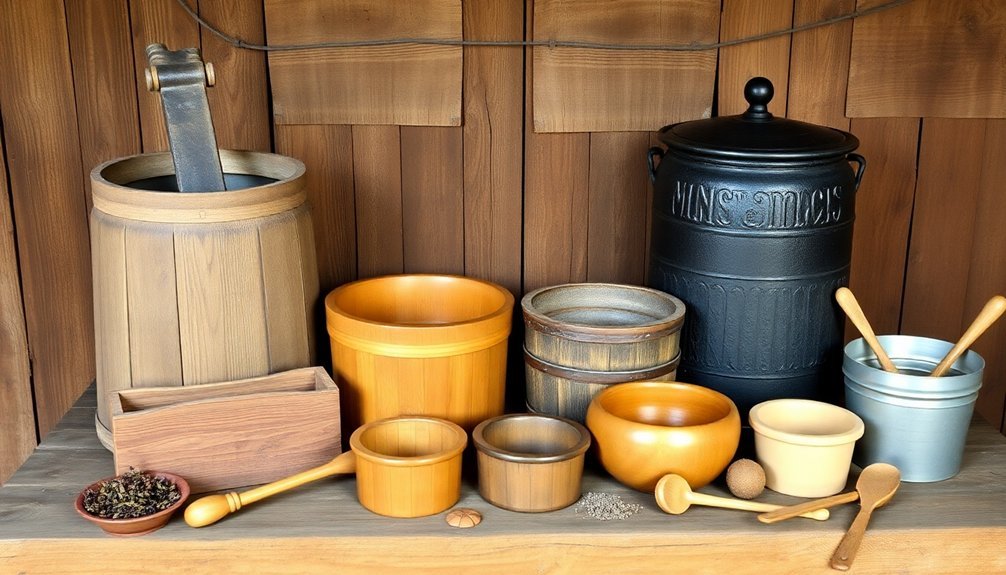
Three essential components formed the foundation of colonial soap making, with the ash hopper standing as the most vital first step in the process.
If you're collecting authentic soap making tools, you'll want a traditional ash hopper—typically a wooden or stone container designed to leach lye from hardwood ashes.
These ingenious leaching systems allowed colonists to transform waste into valuable resources. Water would slowly percolate through the ash-filled hopper, extracting the alkaline lye solution necessary for soap making.
The filtering layer of straw or cloth guaranteed only the liquid passed through.
For peak lye extraction, proper maintenance was imperative. Collectors should note that authentic hoppers show signs of regular cleaning and filter replacement.
Cast Iron Soap Kettles and Hearth Equipment
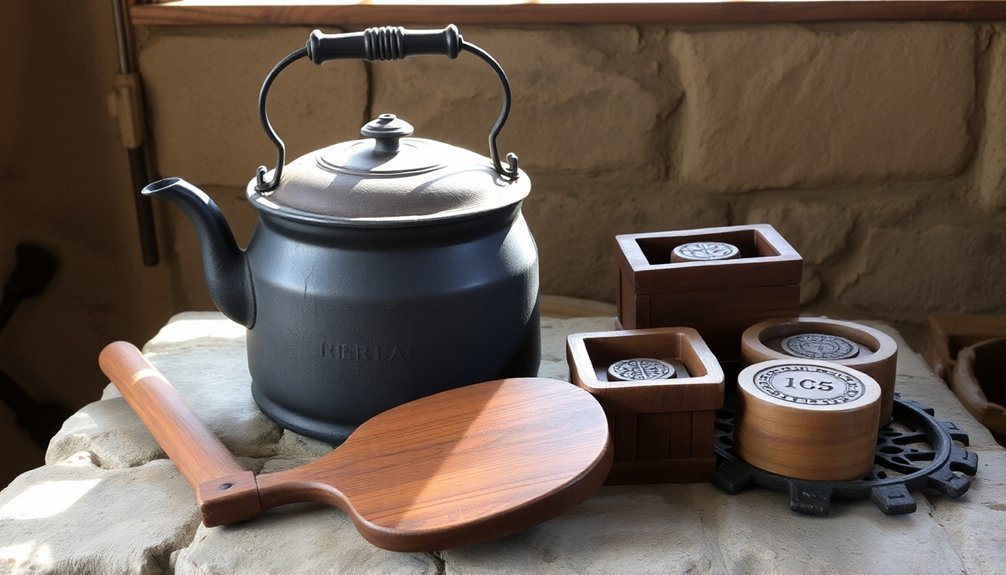
With lye prepared from the ash hopper, colonial soap makers turned to their heavy cast iron kettles—workhorses that transformed raw ingredients into usable soap.
You'll find these kettles particularly valuable for their durability and even heat distribution, essential for the precise saponification reaction that turns fats and lye into soap.
The kettles' thick bottoms prevented scorching during the long process of boiling lye with animal fats. Accompanying hearth equipment, including trivet stands and fire tools, offered practical solutions for managing open flames safely.
Many colonists crafted these implements themselves, showcasing their resourcefulness.
When collecting authentic colonial soap making tools, look for kettles with signs of outdoor use—a common practice that kept unpleasant odors outside the home while reducing fire hazards.
These practical vessels represent the ingenuity of early American domestic life.
Wooden Stirring Paddles and Mixing Tools
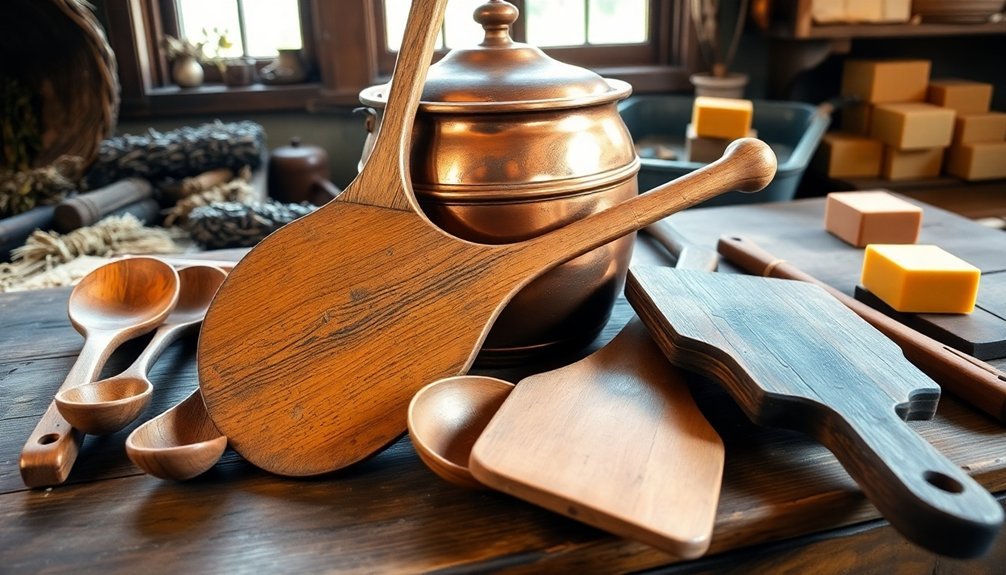
While lye and fat formed the essential ingredients of colonial soap, the humble wooden paddle served as the soap maker's primary tool for transforming these raw materials into usable product. You'll find these handmade implements were typically crafted from hardwood, measuring three to four feet to keep artisans safely distanced from bubbling cauldrons.
| Feature | Purpose |
|---|---|
| Hardwood construction | Durability against warping |
| Broad, flat end | Effective incorporation of air |
| Extended length | Safety during the mixing process |
| Personalized carvings | Identification and decoration |
| Wide stirring surface | Even saponification process |
The mixing tools weren't merely functional—colonial soap makers often personalized them with distinct patterns or initials. These durable paddles withstood the rigors of stirring hot mixtures while preventing damage to the developing soap, making them collectible artifacts of early American craftsmanship.
Soap Molds and Cutting Implements
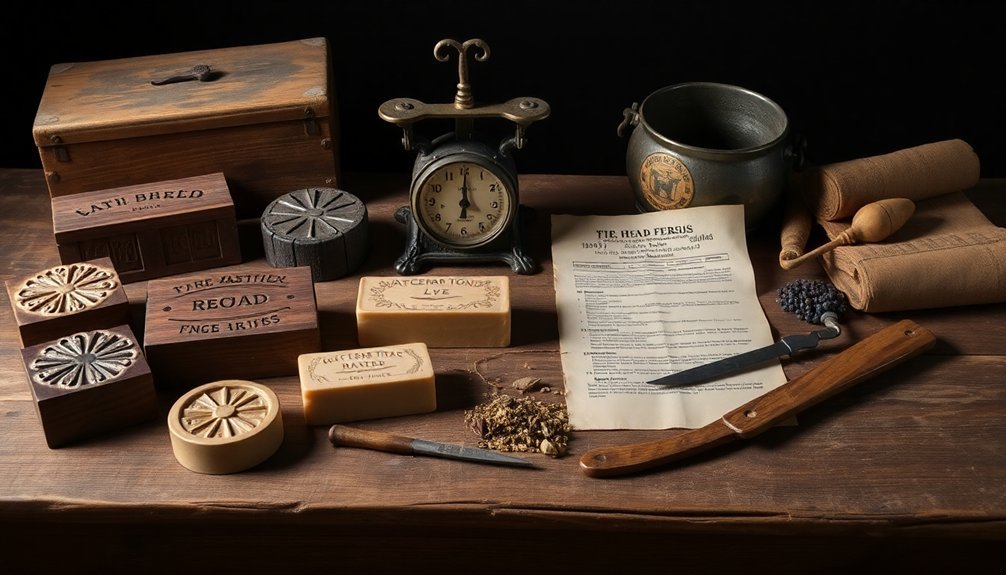
Craftsmanship in colonial soap making extended beyond stirring to the final shaping process. While modern silicone molds weren't available to early artisans, today's collectors appreciate authentic wooden molds that provide traditional charm to cold process soap making.
You'll find stainless steel soap cutters essential for achieving the uniform bars of soap that colonial craftspeople created with simple tools. When incorporating essential oils into your melt and pour soap, multi-bar cutters guarantee consistency across your entire batch.
Whether you prefer scalloped or straight edges, investing in quality cutting implements elevates your soap's professional appearance.
For authenticity in your colonial soap making collection, seek out traditional wooden molds alongside more practical silicone options. This combination honors historical techniques while benefiting from modern innovations that make unmolding and precise cutting notably easier.
Fat Rendering Pots and Straining Devices
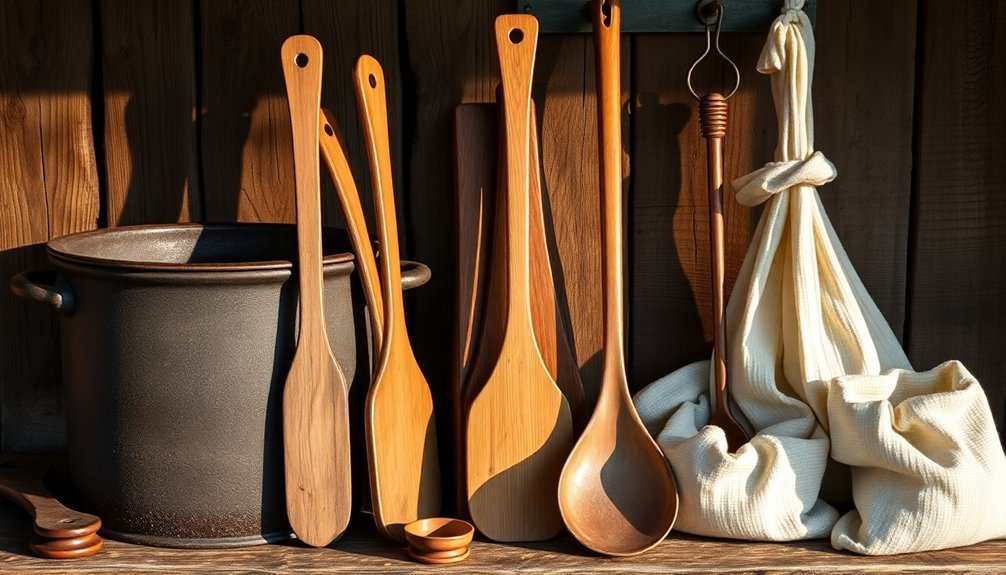
Three essential pieces of equipment anchored the colonial soap making process—fat rendering pots and their companion straining devices created the foundation for quality soap production.
These hefty cast iron pots distributed heat evenly, preventing animal fat from scorching during the critical rendering process.
You'll notice authentic fat rendering pots were designed for outdoor use, where colonists could manage the intense heat and strong odors produced when melting down fats.
After rendering, they'd employ muslin cloths or fine mesh sieves to strain out impurities and gristle, creating cleaner lard for superior soap.
In colonial households, these tools reflected remarkable resourcefulness—often handmade or repurposed from other kitchen implements.
Frequently Asked Questions
Is Soap Making Profitable?
Yes, soap making is profitable. You'll find 30-50% profit margins are possible when you sell artisanal soaps for $5-15 per bar. With the market growing to $40 billion by 2027, it's a viable business opportunity.
How Many Bars of Soap Does 2lbs of Melt and Pour Make?
You'll get about 8-10 standard-sized bars from 2 pounds of melt-and-pour soap. Each bar typically weighs 4-5 ounces, but your exact yield depends on your mold size and any additives you're using.
What Did They Use for Soap in the 1700S?
In the 1700s, you'd make soap using animal fats (especially pig lard) combined with lye made from wood ashes. You'd boil this mixture outdoors in cauldrons, creating soft soap that was scooped from containers.
What Is the Best Bowl for Soap Making?
You'll want a stainless steel or heat-resistant glass bowl with a wide opening and deep base. It should have a heavy bottom for stability and clear measurement markings for accurate mixing of ingredients.
In Summary
You'll get immense satisfaction collecting these authentic colonial soap making tools. They not only preserve history but also allow you to experience traditional craftsmanship firsthand. Whether you're displaying ash hoppers and cast iron kettles or actively using wooden paddles and soap molds, each piece tells a story of ingenuity and self-sufficiency. Start your collection today—you're preserving valuable artifacts from America's early domestic arts for future generations.





Leave a Reply